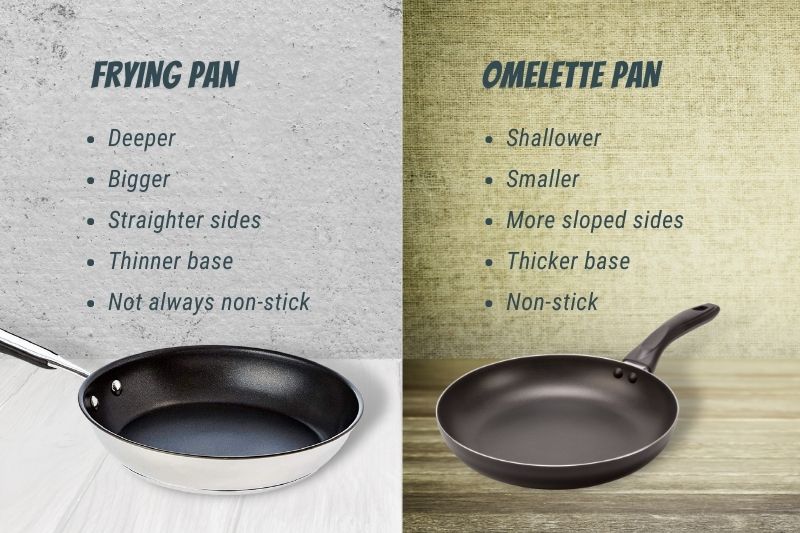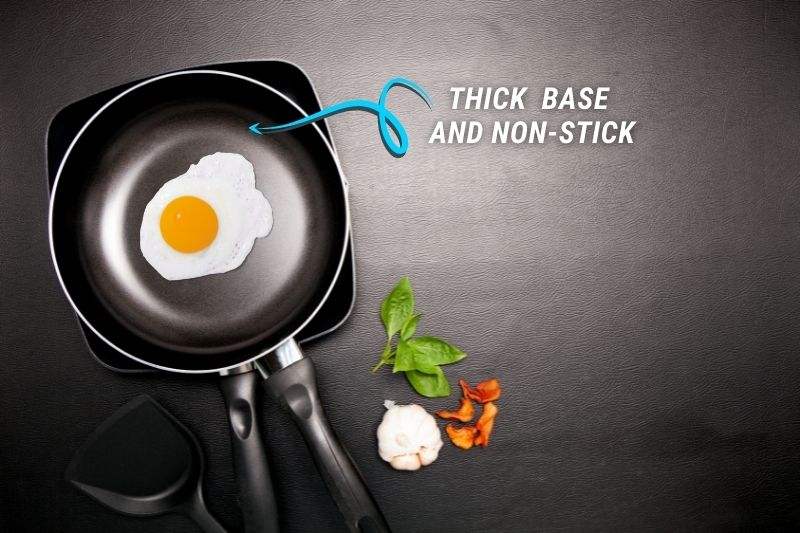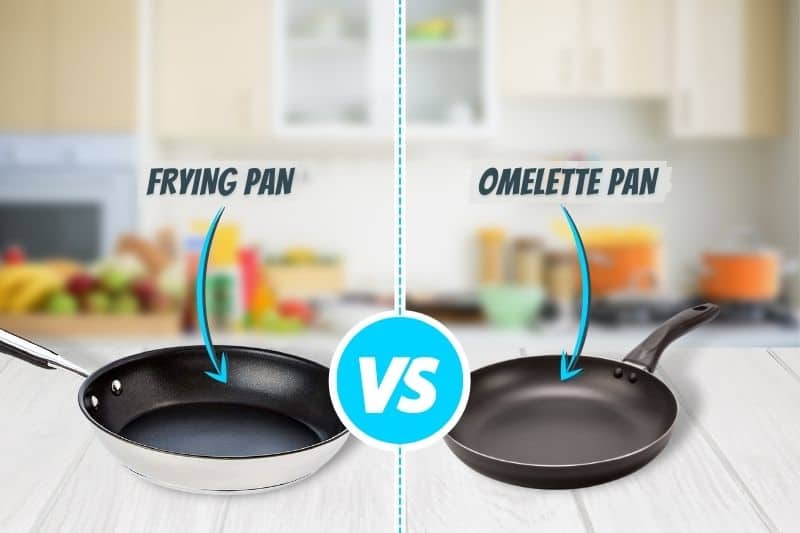While there are some similarities between the two, an omelette pan is usually smaller and shallower than a frying pan. It also has slightly sloped sides to make it easier to flip your omelette. The shallow walls allow you to ‘pour’ your omelette onto a plate.
A frying pan typically has straighter, longer sides (with a slight curve), so you can fry or sauté your food without making a mess.
As the name suggests, an omelette pan is designed specifically for omelettes and other types of egg-cooking, whereas a frying pan is designed for a multitude of foods.
Naturally, you can, of course, cook an omelette in a frying pan, but unless you’re very skilled or experienced in the art of omelette-making (and there certainly is an art to it!), you’re advised to stick with your omelette pan to ensure your omelette is top-notch!
Differences Between a Frying Pan and an Omelette Pan

Here’s a summary of the differences.
Frying pan
- Deeper
- Bigger
- Straighter sides
- Thinner base
- Not always non-stick
Omelette pan
- Shallower
- Smaller
- More sloped sides
- Thicker base
- Non-stick
Benefits of Owning an Omelette Pan

One of the main advantages of using an omelette pan (instead of a frying pan) to cook omelettes is that it has a thicker bottom. This is ideal for cooking eggs, which are prone to burning quickly.
The thick base will also prevent your pan from warping, which is a common problem with thinner metal pans, and will ensure even-cooking of your omelette.
Naturally, a key feature of the omelette pan is that they are non-stick, which can be the make-or-break factor of whether your omelette will indeed be an omelette and not scrambled eggs!
Because of the thick base, an omelette pan can be great for cooking other foods prone to burning, such as Julienne-cut vegetables.
Benefits of Owning a Frying Pan

The frying pan is a great way to get heat quickly into the surface of something, such as a rare steak, and will allow you to cook a plethora of foods such as meats, vegetables, and even high-carb flour-based foods, such as pancakes, crepes, and tacos.
You will usually need oil, but not always. If you use a non-stick frying pan you can to minimise the use of oil in your cooking.
Naturally, given the name, frying pans were designed to cook foods by way of frying and deep-fat frying. Frying pans are great because they draw heat quickly and are perfect for quick, easy one-pan meals. They’re up there with skillets in terms of versatility!
Omelette Cooking with a Frying Pan

If you’re unsure of investing in an omelette pan and just want to use your frying pan, it can be done!
The base of a frying pan is a lot thinner than an omelette pan, which means you’re more likely to burn your eggs, so the trick is to cook your omelette on a lower hob heat, but for longer.
If you don’t want to risk flipping your omelette, you can finish it in the grill, which will ensure the top of your omelette is cooked properly.
If all this sounds like too much faff then, well, get yourself hooked up with an omelette pan and save yourself the hassle!
Conclusion
While you can get away with whipping up a decent omelette without an omelette pan, if you are serious about your breakfast game (or own a restaurant), having an omelette pan at hand will absolutely make the task of creating an Instagram-worthy omelette a lot easier!
They are specifically designed for cooking eggs, which can be volatile when it comes to heat. Egg white cooks extremely quickly, which is why the omelette pan factors in all the potential omelette obstacles, such as too much heat too quickly/uneven cooking, thanks to a warping pan.
The shallow, curved walls and “lip” on an omelette pan allow for pouring your omelette onto a plate without needing a lifter or spatula to lift it out with. All of this serves to make your omelette-making endeavours much smoother!

Clara is a freelance writer and former chef. Though she may have hung up her apron, her love of food and cooking is still going strong! When she’s not whipping up a verbal storm, she’ll be in her kitchen sipping wine and whipping up a culinary storm.







